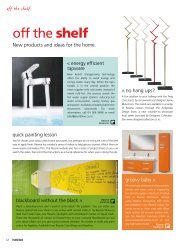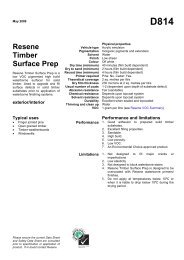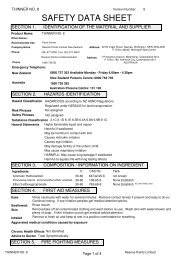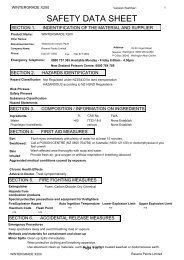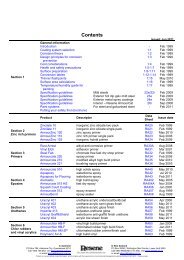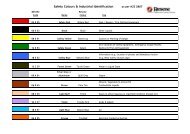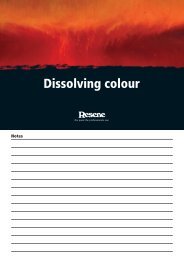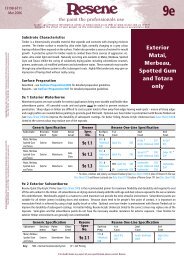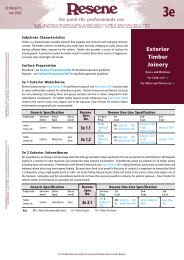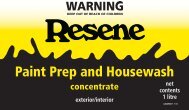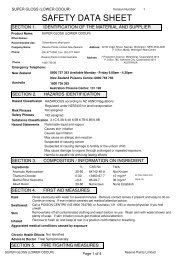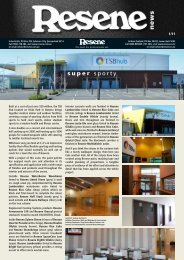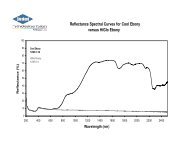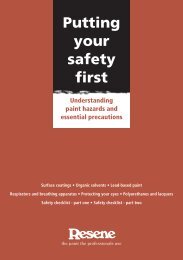Create successful ePaper yourself
Turn your PDF publications into a flip-book with our unique Google optimized e-Paper software.
<strong>Resene</strong> Professional development programmeGood <strong>painting</strong> practice emphasises the importance of preparation, particularly <strong>for</strong> re<strong>painting</strong> andcleanliness is the key! Cleaning is easily achieved with Sugar soap and propriety solutions like <strong>Resene</strong>Interior Paintwork Cleaner and because it is an integral component of <strong>painting</strong> specification <strong>rates</strong> areincluded separately to actual coating costs.Step 1 – WashingWashing be<strong>for</strong>e <strong>painting</strong> interior walls, ceilings and joinery etc is good practice to remove any fly dirt, dust and othercontaminants. In most situations this means simply wiping using a clean lint-free cloth and a solution of warm waterand <strong>Resene</strong> Interior Paintwork Cleaner or a mild detergent. Sanding walls and ceilings is not usually necessary unlessthe surface has imperfections and/or flaking paint that needs to be sanded smooth, or if the existing paint systemis an old enamel system.If it is an enamel system, commonly used in kitchen and bathroom areas and on joinery and doors, first remove anygrease and oil using Sugar soap and sand the areas to degloss the surface and provide a key <strong>for</strong> the paint to adhereto. Alternatively <strong>Resene</strong> Waterborne Smooth Surface Sealer (D47a) could be used eliminating the requirement tosand.Note 1: Pen marks will need to be sealed with either <strong>Resene</strong> Sureseal (D42) or <strong>Resene</strong> Enamel Undercoat (D44) asthey will bleed through waterborne paints.Note 2: You can check whether the paint finish is an enamel system by rubbing the paint surface with meths. If itremoves some of the coating then it is most likely waterborne and a <strong>Resene</strong> paint system can be applied directly ontothe clean surface without sanding.Step 2 – FillingAny holes or voids, such as those left in wallboards by picture hooks, should be filled and once dry sanded smooth.Unless the hole in the wallboard is large (say bigger than the palm of your hand) it will not usually need sealing orpriming be<strong>for</strong>e <strong>painting</strong>.For timber joinery it is good practice to spot prime voids and holes, such as punched nailheads, be<strong>for</strong>e filling andthen reprime once filled and sanded. The tables below are guides to the most suitable sandpaper, fillers and primers/sealers to use.You are now ready to paint.Sanding and scrapingArea Scraper First sandpaper FinishingsandpaperFine finishing – clear finishes - 220 grit zinc stearate 400 grit Wet and DryRough and/or flaking woodwork or wallliningsSanding between costs, enamels, clearfinishing25mm-50mm flat 100 grit zinc stearate 220 grit zinc stearatebladed scraper- 220 grit zinc stearate -Sanding fillers <strong>for</strong> joinery, skirting boards etc - 180 grit zinc stearate -Sanding fillers on wall linings - 220 grit zinc stearate -Sanding wallboards after removing wallpaper - 80 grit zinc stearate -Wallboard compounds, <strong>Resene</strong> BroadwallSurface Prep and Seal (D807), <strong>Resene</strong>Broadwall Waterborne Wallboard Sealer(D403)- 180-220 grit zincstearate – ideallywith a pole sander-21



